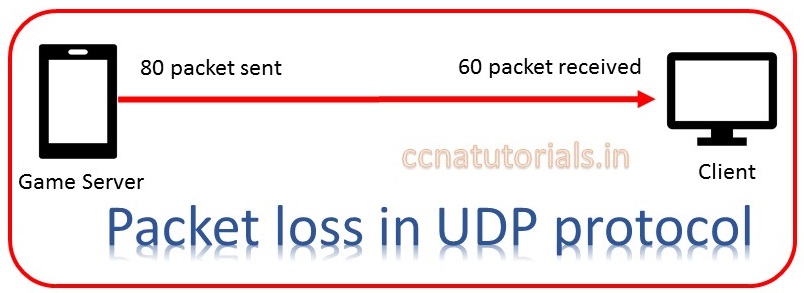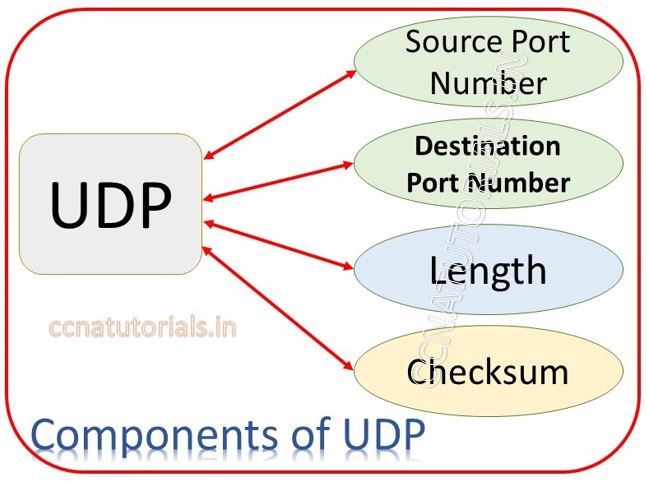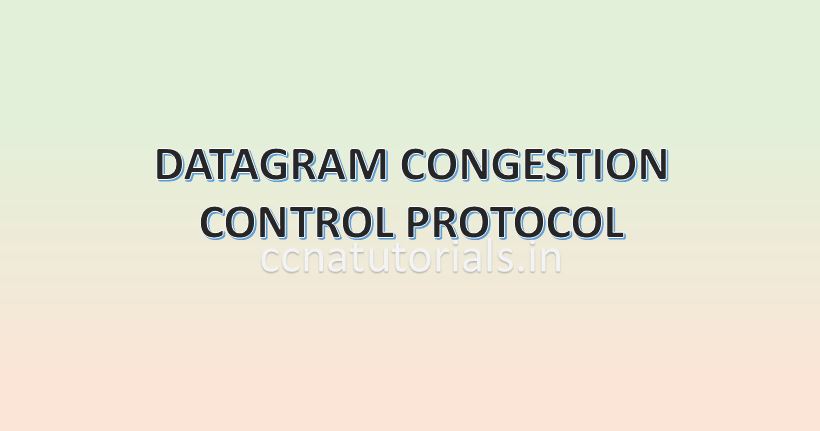In this article I describe the UDP User Datagram Protocol in computer network for CCNA exam. UDP User Datagram Protocol is related to Transport layer of TCP/IP Suite model. The UDP User Datagram Protocol provides the real time data transfer between different networking devices on a computer network . UDP User Datagram Protocol provide the fast but not reliable data transfer between different networking devices on a network or internet. UDP User Datagram Protocol mostly used for broadcasting the audio or video so if some part goes missing it will not effect to the user.
UDP User Datagram Protocol allow the data packet transfer from one device to another like online video streaming with loss of some data packets. UDP User Datagram Protocol does not take any acknowledgement after sending the data packets in the network. In case of failure of data packet received UDP does not allow to resend the missing data packets on the network. Routing and Routed Protocols provides the connectivity between different networks for data packets flow from one network to another network. A standard routing table is maintained by the routers for data packet flow between different networks.
Before going to learn about UDP User Datagram Protocol we need to remember the OSI suite and TCP/IP suite model. There are many manufacturer of computer machine in the market. Initially when computers became single user public computer. The computers communicate with only same brand machines. It happens because there was no any fix standard for data transfer between different devices. It is very difficult to make communication with each other when the hardware are of different brands or company. In this article I describe the some basic part of OSI reference layer and TCP/IP Suite model basic concepts in networking with the UDP User Datagram Protocol.
OSI reference model basic concepts
OSI reference model in computer network followed by various vendors to overcome the compatibility problem. After implementation of OSI reference model in computer network, equality maintains by all manufacturer. In 1970 the Open Systems Interconnection (OSI) reference model was created by the International Organization for Standardization (ISO). The OSI model was meant to create inter-operable network with different manufactured devices. In this article I describe some layered approach of TCP/IP Suite model basic concepts in computer network. Before understanding the TCP/IP Suite model basic concepts it is necessary to know about the 7 layers of OSI reference model because the basic work of each layer is described in the OSI reference model. You can read the full article related to OSI reference model in computer networking here.
Importance of OSI reference model for UDP User Datagram Protocol
Before going to know about the UDP User Datagram Protocol. It is necessary to know the function of layers in OSI model and TCP/IP model. Initially not only hardware but software also not supported for work the different computer brand. It became very difficult for all computer users to working without implementation of OSI reference model in computer network. It is necessary then to make some common protocols for all vendors of computer. Before implementation of OSI reference model in computer network, all vendors implements their own protocols on computer hardware and software.
In networking OSI reference model became helpful. OSI reference model describes the flow of data between nodes in any network. Data from one computer application to another computer application transfer by following some common protocols. The OSI reference layer also become beneficial for troubleshooting the network problems. TCP/IP and Cisco three layered hierarchical model of Cisco became more helpful alongside the OSI reference model.
The Layered Approach in computer network for UDP User Datagram Protocol
The Layered approach was the best way to make equality for all computer devices. Layers are not physical but following some protocols. Protocols are for connectivity, connections, data transfer and more. All manufacturer begin to follow the layered approach for OSI reference model in computer network. The OSI reference model change in TCP/IP reference model and later on Cisco three layered hierarchical model. OSI layer architecture have 7 layers. TCP/IP reference model convert these 7 layers into only four layers. After that Cisco three layered hierarchical model converts these 7 layers into three layers. Some layers combined to work in a single layer.
OSI is acronym for open system interconnection. The OSI is a logical reference OSI reference model in computer network. OSI model helps for data flow between different devices and operating systems. All manufacturer used their own architecture before invention of OSI reference model. It was very difficult to establish data communication between different devices. To overcome this problem international organization for standardization (ISO) created the open systems interconnection (OSI) reference model. OSI reference model make data flow possible between different operating system, devices and hardware. Later the OSI model adopted by Cisco as Cisco three layered hierarchical model.
Structure of OSI reference model related to UDP User Datagram Protocol
OSI reference model in computer network consist of 7 layers. These 7 layers further divided into two groups. First 3 layers works for application communication and remaining 4 layers works for data flow. Application, presentation and session layers define the application communication. Transport, network, data link and physical layers define the data flow. Networking protocols works only on last four layers.
TCP/IP Suite model basic concepts for UDP User Datagram Protocol
TCP/IP is acronym for Transmission Control Protocol/Internet Protocol (TCP/IP suite model). In this section of the article I describe about TCP/IP suite model basic concepts in detail. TCP/IP suite model is a reference model like OSI layers. Instead of 7 layers of OSI reference model. TCP/IP suite model consist only four layer. All seven layers are merged into four layers only. TCP/IP suite model was designed and implemented by Department of Defence (DoD). TCP/IP developed to preserve data integrity.
The main purpose to develop the TCP/IP is to provide security in the network. A lots of protocols works on each layer to provide a secure network.
It is necessary to understood the protocols used in TCP/IP Suite model basic concepts. IP addressing play an important role in TCP/IP Suite model basic concepts. By using the IP address and subnet masking broadcast domain breaks. It will improve the performance of the network. Breaking broadcast domain increase the data flow speed. Here IP stands for IPV4 only. We ignore the IPV6 for some time in this article. It will make it easy to understand the TCP/IP Suite model basic concepts.
A snap of TCP/IP Suite model basic concepts
In the decade of 1970’s TCP/IP suite model developed by DoD. In the initial stage TCP/IP suite model divided into two segments TCP and IP. Later its name registered with combined name of TCP and IP like TCP/IP model. ARPA, the Advanced Research Projects Agency of DoD officially authorised to use TCP/IP suite model. TCP/IP model was working well so it was adopted by many organisations. In today scenario it is mostly using reference model for networking. Internet is the best example of using TCP/IP.
Process or Application layer of DoD model in TCP/IP Suite model
This is the first layer of TCP/IP of DoD model. It is combination of top three layers of OSI reference model. The functions of Application layer, presentation layer and session layer in OSI model works in single layer process layer. This layer supports the point to point communication and controls the user interface. The data encryption and decryption also done at this layer. Example of some protocols functions at this layer are TLS Transport Layer Security, FTP, LPD, TFTP, SMTP.
Transport layer of DoD model in TCP/IP Suite model
Transport layer of TCP/IP is same as the Transport layer of OSI reference model. It supports the TCP and UDP protocol. This protocol converts the main data segment into packets and transport to the internet layer. The responsibility of Transport layer is to combine the segments and built the data. The data should be reconstruct in its real form. Transport layer is also responsible for creating end-to-end communication between sender and receiver. This layer ensure the delivery of segment in sequence at the receiving device. This property maintains the data integrity.
Internet layer of DoD model in TCP/IP Suite model
Internet layer of TCP/IP is similar to the network layer of OSI reference model. Routing protocols functions on Internet layer of TCP/IP model. Addressing and filtering of packets is main responsibility of Internet layer of TCP/IP model. This layer provides the transmission of packet in the whole network. Some example of protocols functions on internet layer are ICMP, ARP and IP.
Link layer of DoD model in TCP/IP Suite model
Link layer is the least layer of TCP/IP. Basically link layer is combination of data link and physical layer of OSI reference model. Link layer is also known as Network Access layer. It works on MAC address based data transmission. Link layer handles the frame and bits. It receive the bits and constructs frame from merging bits in a sequence. In case of any bit is missing this layer request to re transmit the bits. Ethernet, FDDI, WAP etc functions on this layer. There is no any preset specification for link layer. Link layer functions on any type of existing media.
UDP User Datagram Protocol explained in brief
UDP User Datagram Protocol is a communication protocol. UDP is transport layer protocol in TCP/IP model. UDP provides data transmission between devices in a network similar to TCP protocol. UDP User Datagram Protocol works on IP address system. UDP User Datagram Protocol doesn’t ask for acknowledgement like TCP Transmission Control Protocol. UDP is independent of software, hardware or media of devices in a network. UDP works on network layer in OSI model. Data loss not recovered by sending device using UDP. Live video streaming is an example of UDP User Datagram Protocol. Many time you see during live video streaming the lost clip never play again.

Data flow in the form of packets in a network on UDP User Datagram Protocol. Source and destination defined by IP address system. UDP control the flow of data in a network. UDP protocol doesn’t manage the reliability and accuracy of data transferred from one device to another device. If data is missing or lost during transmission, then the lost data not transmitted again from source to destination. UDP is a connectionless protocol.
Purpose of UDP User Datagram Protocol
UDP User Datagram Protocol provides communication between two devices on internet. In UDP protocol datagrams sent instead of packets in TCP. UDP is a connectionless protocol. UDP does not provides flow and error control on data transmission over internet. Some services do not require accuracy or reliability of data transmission. These services are providing data communication by using UDP User Datagram Protocol. Video streaming, DHCP services are example of such services.
Function of UDP User Datagram Protocol
UDP protocol provides communication for network applications. The application in which latency is critical. Voice and video communication use UDP protocol. During communication if some part of voice or video is loss, it doesn’t affect the communication. Remember VOIP used TCP protocol to get accurate voice data. Application use UDP protocol can suffer some data loss without adversely affecting on its data quality. Some protocols which use UDP User Datagram Protocol for their services are TFTP, RTSP, and SNP etc.

UDP User Datagram Protocol send packet from all the path which are available on network. Due to this some packets received in different sequence and dropped by receiver. Some packets dropped during transmission which is suitable for real time applications. Mostly real time application use UDP Protocol.
Composition of UDP User Datagram Protocol packet
UDP Protocol header use four fields for transmit the data. Each of them is of 2 bytes. The four fields are source port number, destination port number, length and checksum.

Source port number assigned at the sender side. It is used to denote the type of service for which data transmission is required. Destination port number denotes the type of service at receiver end for which data is sent. Length defines the length in bytes of a packet or encapsulated data. Finally, checksum check the error in data transmission. Both IPv4 and IPv6 are compatible for UDP Datagram Protocol.
In this article I describe the UDP User Datagram Protocol in computer network for CCNA Exam. I hope you found this article helpful for any query or suggestions you may drop a comment below or contact us. Your suggestions are always welcome by us.




